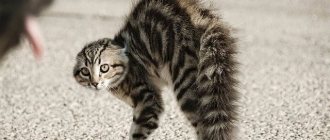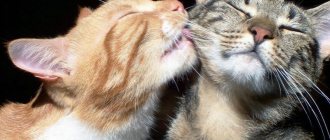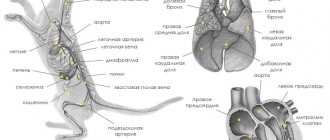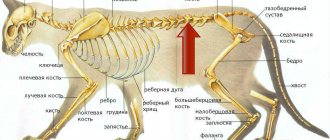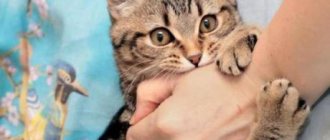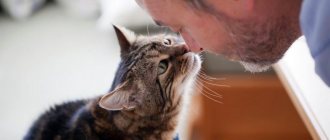If a cat hisses at a kitten or person and snorts, then in a similar way the pet may be showing aggression or fear. A cat getting angry and rushing when defending its own territory, or aggressive behavior towards its owner may be a sign of resentment. This condition in an animal should not be left unattended, since hissing is often one of the symptoms of a serious illness. Therefore, as soon as the cat becomes aggressive and starts hissing, it is recommended to contact a veterinary clinic.
A characteristic feature of some breeds
For cats of certain breeds, hissing is a mandatory element of communication. This is how they try to convey important information. For example, Abyssinians and Cornish Rex hiss when they want to run and frolic, but there is no such opportunity. These cats are very active and the restriction of their mobility causes dissatisfaction. Cats, owners of fluffy coats made of long hair, will hiss if you want to stroke them after they have spent a long time and concentratedly putting their “outfits” in order. Vulnerable hairless Egyptian cats will definitely react if you touch them with cold hands. There are also breeds for which there is no need for a reason to hiss at all. These are aggressive Siamese and Bengal cats.
Hissing as an expression of dissatisfaction and readiness to attack
The ability to see the reasons for a negative reaction and predict further actions underlies the problem-free coexistence of a person and a freedom-loving cat in the same territory. In order not to aggravate the conflict with the hissing cat, it is strongly recommended not to:
- Imposing your company on the cat and pestering it with food or toys . A pet who is in a bad mood has no time for entertainment, and his appetite at such moments noticeably worsens.
- Try to calm the cat by stroking it . At the moment of inflated feelings, a pet may react inappropriately to an outstretched hand, hitting with a clawed paw and leaving a bloody trail.
- Take the cat in your arms and cuddle it . Most likely, such an attempt will immediately fail, and the angry or frightened cat will become even more furious. Some pets may freeze for a moment in the owner’s hands, but then begin to break free with renewed vigor, dodging and using their teeth and claws.
- Block the animal's escape route . The running cat defiantly asks to be left alone. But if the owner is persistent and begins to chase the animal or tries to detain it, he will certainly cause an outbreak of aggression.
- Trying to get the cat out of hiding. A cat's house is an inviolable personal space, so there should be no intrusion from the outside. An animal huddled in a nook is in a state of stress and seeks salvation in an accessible shelter, and if it tries to bother you, it will most likely launch a serious attack.
Fright
Anything can scare a cat: an unfamiliar environment, a stranger, an incomprehensible smell, a sharp and loud sound. Sometimes fear is associated with unpleasant memories. For example, when visiting a veterinarian, a cat remembered pain and a frightening smell. Finding itself in the same situation after some time and hearing the same aroma, the cat hisses. Try to distract her with something tasty or pet her.
Main causes of hissing
A cat is an emotional and very sensitive creature. Don’t think that she shows her mood less than a dog. The cat just has a different language of communication. It is less visible and less understood by people. Hissing brings together a wide range of feelings:
- Aggression. Aggression is rather a collective term. It combines all the negative emotions that a cat experiences. An animal that is not large in size, but is considered a predator, cannot solve problems in any way other than aggressive defense. The cat rarely attacks, only during the hunt. Everything else is nothing more than protection.
- Irritation. A pet can experience this feeling for a variety of objects. The most common irritants are children. They often cause negative emotions in a cat with their mobility and can cause pain or other discomfort. Hissing is a menacing sound. It repels the irritant well, and he is forced to leave the animal alone.
- Pain. If a cat is in pain, the best thing it can think of to protect itself from unnecessary attention is hissing. It is unlikely that anyone would want to touch a pet in such a state. The gaping mouth with sharp fangs looks painfully impressive, and even more so the claws. Physical discomfort is a direct signal of the animal’s current incapacity. How else can a cat save and protect itself from the threat? Just to show that she can stand up for herself.
- Fear. Here comments are unnecessary and speak for themselves. Pain and fear usually go hand in hand. Therefore, the manifestation of emotions is the same and is accompanied by hissing. There is only one meaning: protecting yourself. Typically, the manifestation of fear is accompanied by more than just hissing. The cat bristles its whiskers and fur, trying to show that it is a very large animal and definitely not worth messing with.
“I’m big and scary, it’s better not to mess with me,” the cat seems to say when it hisses and bristles its fur
- Warning. The cat doesn't like to attack at all. She's too small. But despite all this, she’s not stupid. She knows perfectly well whether she can cope with the enemy or not. But this is in the wild. It's different for domestic cats. The pet knows its owners well, it trusts them, but if they cross the boundaries of subordination, then before putting the offender in his place, the cat sends a warning in the form of a hiss. This works well on those who have the audacity to disturb her peace.
- Sexual irritation is a more complex feeling. There is a whole range of relationships here: protecting the boundaries of the territory, the fight for the female, possessive instincts. The hissing is intended to both warn and scare the opponent.
- Danger. Danger is always accompanied by fear. The desire to defend herself, to show that she can fight back, will be accompanied by the cat's hiss. This is how the animal conveys a warning to the offender or a signal of danger to relatives or owners.
Video: reasons for aggressive behavior in cats
Mistrust of the owner
We cannot always cope with our emotions, especially when an animal “behaves incorrectly” in our understanding. Some are capable of not only screaming, but also hitting the cat. Having remembered the insult, the pet will be afraid of repeating the situation. A cat also hisses at its owner when you took an adult animal from the street or when the previous owners treated it poorly. Not remembering anything good from people, the cat will be wary of you for a long time. It will take a lot of patience and love to overcome the path from mistrust to understanding, and attacks of aggression cannot be avoided.
"Hises like a snake"
Hissing is a very specific sound, eloquently indicating a strong negative reaction. A surge of irritation and negative emotions confirms the entire appearance of the animal:
- open mouth with demonstration of the entire combat set of teeth;
- burning eyes with dilated pupils;
- ears pressed to the head;
- an angry bristling mustache;
- raised wool.
Associated reactions. Depending on the degree of threat and personal temperament, the severity of the defensive reaction is not always the same, so a hissing cat may:
- At the next moment, quickly retreat, fleeing.
- Take a characteristic pose with an arched back and fluffy tail raised up, which means a more serious attitude and an attempt to intimidate the enemy.
- Apply several blows with a clawed paw, while grouping yourself and pressing your stomach to the ground, which symbolizes the intention to fight. The tail twitches nervously or whips from side to side.
Who is guilty. Dissatisfaction, fear and aggression, encrypted in hissing, can be directed both at a specific living object (a rival cat, a dog, a stranger) and “into space”, being initiated by a sudden loud sound or a flashing shadow. Regardless of the source, the cat's expression of displeasure, when further provoked, can develop into an attempt at violent self-defense and end in a harsh aggressive attack.
Territory defense
If a new person appears in the house, and even more so another animal, the cat will definitely strive to prove its right to the territory. If you get another pet, be prepared to be on guard at first and maybe even break up fights. The cat is sensitive to encroachment on any of its places, its favorite toys and human attention. You need to be patient and give her a little more attention. Pet the cat, show it that you love it, and over time there will be peace in your home.
Breed characteristics
The character of a cat largely depends on the breed. For some breeds, hissing is a way of conveying information.
- Siamese cat. Although this is a fairly popular breed of domestic cat, almost all Siamese have a difficult character. If you've ever been scratched by a Siamese cat, you won't forget it for a long time. And if you yourself are the owner of a “Siamese”, then most likely you will constantly walk around with scratches. “Siamese,” among other things, are also cunning and insidious: if they decide that they are offended by you, they may not take revenge immediately, but after a while they may take you by surprise.
Siamese cat
- Bobtail. At first glance, bobtails with tails reminiscent of rabbits look cute and innocent. But they are close relatives of the Siamese, so they have a suspicious and independent character. It is even recommended to keep cats of this breed as guards if for some reason you cannot get a dog.
Bobtail
- Abyssinian breed. Like the Siamese, they tend to take revenge for insults. They can snap even in a harmless situation. Abyssinians need constant attention. Otherwise they run wild.
Abyssinian cat
- Maine Coon. These “muscles” from the cat world can weigh up to 15 kg. They appear to be good-natured and lazy, and sometimes there are recommendations to have them for children. But you should be careful with Maine Coons.
Maine Coon
- British Shorthair. The British look like soft plush toys. But in fact, they are very independent and cannot stand it when people treat them with familiarity - pick them up, pull them. The British are accustomed to royal treatment.
British shorthair breed
- Sphinx. Hairless cat breeds may simply not like the fact that you try to pet them with cold hands.
Sphinx
The animal is sick
This is not always how a cat shows aggression. If she lies on her stomach and does not allow herself to be picked up, and her hissing sometimes turns into purring, this is a serious reason to go to the veterinary hospital. By hissing, the cat communicates pain, and by purring it tries to calm itself down. Take a closer look at your pet, he may ask you for help.
If your pet hisses, do not take it as a sign of aggression or displeasure towards you. Perhaps something scared him, perhaps he wants to warn you about something. If the cat tries to hide, do not disturb it and do not scold it in any way. Give her time to calm down, watch her, try to understand and become her true friend.
What does a cat hiss mean?
A cat's hiss is a communication signal, just like meowing, growling, or other nonverbal signs (ear pinching or tail twitching). By hissing, the cat is trying to communicate discomfort: this can be both a manifestation of illness and a manifestation of stress. Be that as it may, hissing is an emotional signal that indicates the internal (physical or psychological) distress of the animal.
A cat hissing is a sign of internal discomfort
